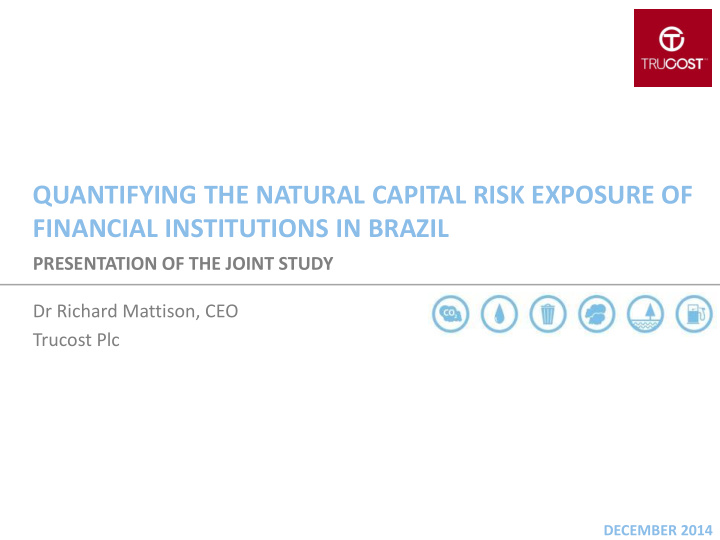



QUANTIFYING THE NATURAL CAPITAL RISK EXPOSURE OF FINANCIAL INSTITUTIONS IN BRAZIL PRESENTATION OF THE JOINT STUDY Dr Richard Mattison, CEO Trucost Plc DECEMBER 2014
CONTENTS • Introduction to Trucost • Importance of this study • What is natural capital and how to we account for it? • Why is this relevant for Brazilian financial institutions in particular? • What are the drivers for internalising environmental costs and why is it a risk now? • Key findings of the report • Case study • Integrating natural capital analysis in equity analysis • Recommendations
ABOUT TRUCOST Trucost helps investors to understand the economic consequences of natural capital dependency in order to identify risk and opportunity from growing natural resource pressures and environmental costs.
IMPORTANCE OF THIS STUDY Some drivers take a long time to materialize and require government intervention but there are other mechanisms by which external costs can be rapidly internalised by economies, companies, investors. This study is a first step to demonstrate how natural capital accounting can be used to analyse companies, portfolios and loans. Investors and banks will need to apply the approach to their own investments in order to quantify the risks . Risk teams need to anticipate these material issues, first quantifying risks to investments and then financing.
What is natural capital and how do we account for it?
NATURAL CAPITAL
NATURAL CAPITAL ACCOUNTING COSTS PER TONNE
WHAT IS THE SCALE? $2.2tn Environmental damage caused by world ’ s largest 3,000 companies >50% Proportion of company earnings that could be at risk from environmental costs 8
VALUING NATURAL CAPITAL HELPS US TO: • DETERMINE IMPACT MATERIALITY • ASSESS ENVIRONMENTAL TRADE-OFFS • UNDERSTAND REGIONAL RISK DIFFERENCES • INTEGRATE THE RESULTS WITH BUSINESS METRICS • COMMUNICATE THE RESULTS TO A GENERAL AUDIENCE
TRENDS IN NATURAL CAPITAL ACCOUNTING LEADERSHIP INITIATIVES INVESTORS SOVEREIGN NGOs CORPORATIONS MULTI-STAKEHOLDER GROUPS
Why is this relevant for Brazilian financial institutions in particular?
RELEVANCE FOR BRAZILIAN FINANCIAL INSTITUTIONS Agriculture accounted for 22% of Brazil’s GDP in Economic reliance on natural capital 2012 Demand and supply side pressures Rapidly growing population Strengthening legislation Potential compliance or litigation costs Equity investments 28% of PF assets invested in equities - high exposure to companies facing natural capital costs Corporate bonds Internalising costs could lead companies to default Corporate lending Food and bev = largest sector for lending and highly dependent on natural capital LACK OF A FRAMEWORK FOR TAKING ACCOUNT OF NATURAL CAPITAL RISK
What are the drivers for internalising environmental costs and why is it a risk now?
FACTORS THAT INTERNALISE AN EXTERNALITY
WHY IS INTERNALISATION A RISK NOW? • Changing demographic • Public awareness • Increasing regulation/voluntary commitments • Market dynamics • Stakeholder action • Climate risks • Resource depletion
Key findings from the report
KEY FINDINGS FROM THE REPORT Unpriced natural capital costs of companies could be as much as R$1,646bn • Banks are most exposed through financing of cattle ranching, fishing, • food and beverages and agriculture Pension funds are most exposed through investments in food and • beverage companies The natural capital risk exposure of financial institutions can vary • significantly
KEY FINDINGS FROM THE REPORT The sectors cattle ranching, soya bean farming, crude • petroleum and natural gas extraction have the highest natural capital costs • The highest natural capital intensity sectors (unpriced natural capital costs per R$m of production) include cattle ranching, fats & oil refining, aquaculture, cotton farming, sugarcane farming and cement manufacturing The North of the country has the highest land use conversion cost • because it is principally made up of Amazon rainforest There is a marked difference in the natural capital impacts of soy production in the • two principal production zones
CREDIT EXPOSURE OF TWO BANKS
NATURAL CAPITAL RISK BY INDICATOR AND NCEX RATIO
NATURAL CAPITAL COST - DIRECT AND SUPPLY CHAIN - AND NATURAL CAPITAL INTENSITY PER SECTOR (WITH AND WITHOUT CATTLE RANCHING)
ENVIRONMENTAL IMPACT ANALYSIS BY SECTOR
GHG AND WATER IMPACTS THROUGH THE SUPPLY CHAIN
REGIONAL COMPARISON
Case Study
BEEF CATTLE RANCHING IN BRAZIL
REGIONAL DIFFERENCES
RISK MATRIX
Integrating natural capital analysis in equity analysis
INTEGRATING NATURAL CAPITAL IN FUNDAMENTAL EQUITY VALUATION
Recommendations
OPPORTUNITIES VALUATION PROJECT DELIVERY REVENUE GROWTH RISK REDUCTION BUSINESS OPTIMISATION New client services Natural capital Low carbon business exposure opportunities Climate volatility Environmental trading Policy risks Low carbon client Insurance costs solutions Resource cost ESG asset management FINANCIAL volatility Green retail banking Client resilience INSTITUTION products Mega trends Resource efficiency Partnership opportunities REPUTATION Stakeholder pressure Peer ranking Talent retention Branding and image
RECOMMENDATIONS 1.Quantify portfolio-level natural capital exposure 2.Identify drivers for cost internalization 3.Demand better data from companies 4. Consider the potential future natural capital risk that a company may face 5.Capitalise on changing market demand for more sustainable goods and services 6.Help customers transition to a more resource efficient and sustainable business model
QUESTIONS
Recommend
More recommend